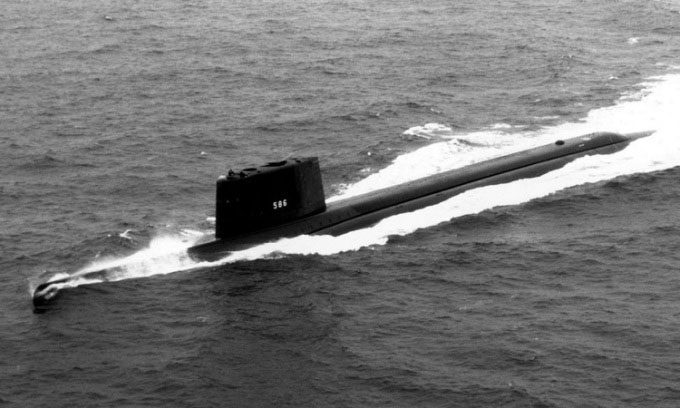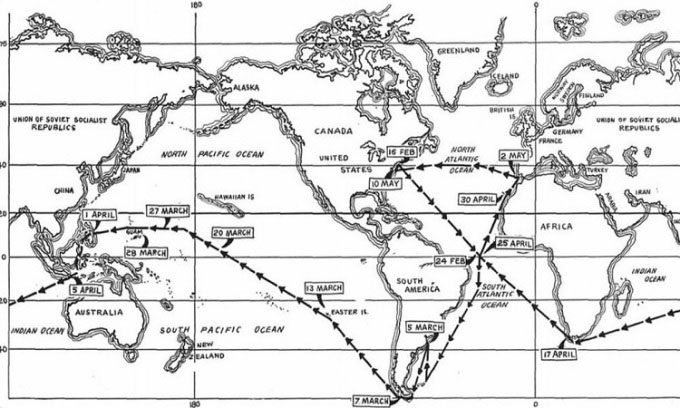Four hundred years after Ferdinand Magellan’s circumnavigation of the globe, a similar project was undertaken in 1960, with the only difference being the vessel used: a nuclear submarine that traveled entirely underwater.

The USS Triton submarine during a sea trial. (Photo: U.S. Navy)
Captain Evan P. Aurand, a naval aide to U.S. President Eisenhower, initiated the first underwater circumnavigation mission known as Operation Sandblast, according to Amusing Planet. To carry out this journey, Aurand proposed the use of the USS Triton, the largest, most powerful, and most expensive submarine built at the time. The vessel is 136 meters long and has a displacement of nearly 8,000 tons. Its two S4G pressurized water reactors provide a total power output of 34,000 KW, enough to propel the submarine at speeds exceeding 55.6 km/h underwater.
U.S. authorities decided that the USS Triton would follow the same route as Ferdinand Magellan and Juan Sebastián Elcano during their first circumnavigation of the Earth from 1519 to 1522. They estimated the journey would take no longer than 80 days, but to be safe, the ship was stocked with enough supplies for 120 days. Triton departed from New London on February 16, 1960, as part of a final sea trial to test the vessel’s operational capabilities after a major overhaul. Only after leaving port did Captain Beach reveal the nature of the voyage to the crew.
The USS Triton arrived at the St. Peter and Paul Rocks in the Atlantic Ocean near the equator, traveling along the eastern coastal waters of South America. The vessel then rounded Cape Horn, heading west across the Pacific Ocean. After navigating through the Philippine and Indonesian archipelagos and passing through the Indian Ocean, the submarine rounded the Cape of Good Hope, reaching the St. Peter and Paul Rocks again on April 25 of the same year, after 60 days and 21 hours. The USS Triton returned to Groton, Connecticut, on May 10, completing the first underwater circumnavigation of the globe. The vessel was submerged for a total of 83 days and 9 hours, covering a distance of 66,633 kilometers.

The circumnavigation journey of the USS Triton. (Photo: U.S. Navy)
In accordance with the mission, the submarine avoided surfacing, except when it was necessary to transfer a sick crew member to the USS Macon off the coast of Montevideo, Uruguay, on March 6. To ventilate, the submarine utilized a snorkel while at periscope depth and maintained position using an integrated periscope system. To dispose of waste without surfacing, the vessel was equipped with a waste disposal unit that shot bags of waste through the bottom of the ship. All repair work was conducted underwater.
Maintaining crew morale during the long duration was the biggest challenge for the captain. They engaged in various activities throughout the week. Keeping the submarine clean was also a challenge. “It was 84 days of actively working to keep the ship clean. It was astounding the amount of dirt we generated, so I scheduled a cleaning day on the weekends. The crew initially protested until they saw the amount of waste we were trying to eliminate. After that, they no longer objected,” Captain Beach shared.
In addition to circumnavigating the globe, the USS Triton collected a vast amount of scientific data about the oceans. The crew took water samples throughout the journey, analyzing differences in chemical composition, salinity, density, and temperature. They also continuously recorded fluctuations in Earth’s gravitational field. Furthermore, the submarine deployed more than 100 hydrographic buoys to monitor ocean currents and map the seabed, including coral reefs and various submerged structures, using sonar and depth sounders. The scientific data from Operation Sandblast has proven invaluable in understanding changes in the ocean.


















































